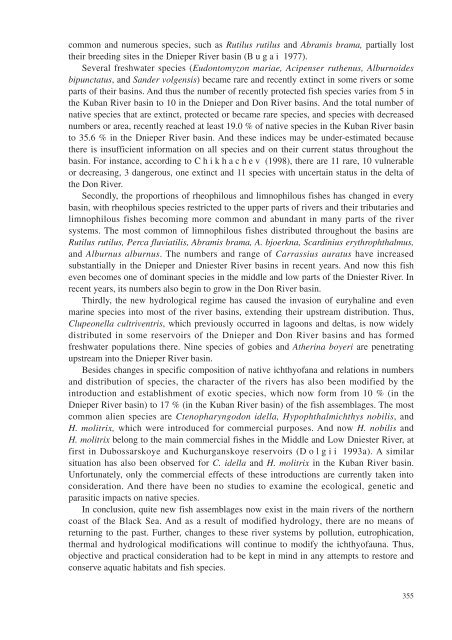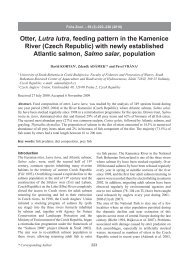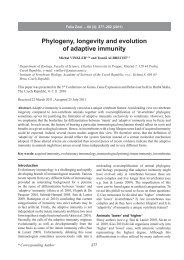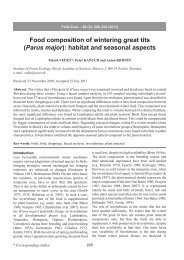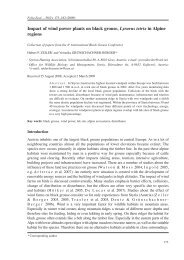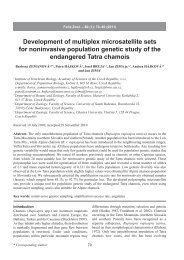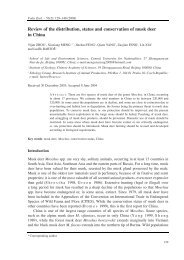alterations in ichthyofauna of the largest rivers
alterations in ichthyofauna of the largest rivers
alterations in ichthyofauna of the largest rivers
Create successful ePaper yourself
Turn your PDF publications into a flip-book with our unique Google optimized e-Paper software.
common and numerous species, such as Rutilus rutilus and Abramis brama, partially lost<br />
<strong>the</strong>ir breed<strong>in</strong>g sites <strong>in</strong> <strong>the</strong> Dnieper River bas<strong>in</strong> (Bugai 1977).<br />
Several freshwater species (Eudontomyzon mariae, Acipenser ru<strong>the</strong>nus, Alburnoides<br />
bipunctatus, and Sander volgensis) became rare and recently ext<strong>in</strong>ct <strong>in</strong> some <strong>rivers</strong> or some<br />
parts <strong>of</strong> <strong>the</strong>ir bas<strong>in</strong>s. And thus <strong>the</strong> number <strong>of</strong> recently protected fish species varies from 5 <strong>in</strong><br />
<strong>the</strong> Kuban River bas<strong>in</strong> to 10 <strong>in</strong> <strong>the</strong> Dnieper and Don River bas<strong>in</strong>s. And <strong>the</strong> total number <strong>of</strong><br />
native species that are ext<strong>in</strong>ct, protected or became rare species, and species with decreased<br />
numbers or area, recently reached at least 19.0 % <strong>of</strong> native species <strong>in</strong> <strong>the</strong> Kuban River bas<strong>in</strong><br />
to 35.6 % <strong>in</strong> <strong>the</strong> Dnieper River bas<strong>in</strong>. And <strong>the</strong>se <strong>in</strong>dices may be under-estimated because<br />
<strong>the</strong>re is <strong>in</strong>sufficient <strong>in</strong>formation on all species and on <strong>the</strong>ir current status throughout <strong>the</strong><br />
bas<strong>in</strong>. For <strong>in</strong>stance, accord<strong>in</strong>g to C h i k h a c h e v (1998), <strong>the</strong>re are 11 rare, 10 vulnerable<br />
or decreas<strong>in</strong>g, 3 dangerous, one ext<strong>in</strong>ct and 11 species with uncerta<strong>in</strong> status <strong>in</strong> <strong>the</strong> delta <strong>of</strong><br />
<strong>the</strong> Don River.<br />
Secondly, <strong>the</strong> proportions <strong>of</strong> rheophilous and limnophilous fishes has changed <strong>in</strong> every<br />
bas<strong>in</strong>, with rheophilous species restricted to <strong>the</strong> upper parts <strong>of</strong> <strong>rivers</strong> and <strong>the</strong>ir tributaries and<br />
limnophilous fishes becom<strong>in</strong>g more common and abundant <strong>in</strong> many parts <strong>of</strong> <strong>the</strong> river<br />
systems. The most common <strong>of</strong> limnophilous fishes distributed throughout <strong>the</strong> bas<strong>in</strong>s are<br />
Rutilus rutilus, Perca fluviatilis, Abramis brama, A. bjoerkna, Scard<strong>in</strong>ius erythrophthalmus,<br />
and Alburnus alburnus. The numbers and range <strong>of</strong> Carrassius auratus have <strong>in</strong>creased<br />
substantially <strong>in</strong> <strong>the</strong> Dnieper and Dniester River bas<strong>in</strong>s <strong>in</strong> recent years. And now this fish<br />
even becomes one <strong>of</strong> dom<strong>in</strong>ant species <strong>in</strong> <strong>the</strong> middle and low parts <strong>of</strong> <strong>the</strong> Dniester River. In<br />
recent years, its numbers also beg<strong>in</strong> to grow <strong>in</strong> <strong>the</strong> Don River bas<strong>in</strong>.<br />
Thirdly, <strong>the</strong> new hydrological regime has caused <strong>the</strong> <strong>in</strong>vasion <strong>of</strong> euryhal<strong>in</strong>e and even<br />
mar<strong>in</strong>e species <strong>in</strong>to most <strong>of</strong> <strong>the</strong> river bas<strong>in</strong>s, extend<strong>in</strong>g <strong>the</strong>ir upstream distribution. Thus,<br />
Clupeonella cultriventris, which previously occurred <strong>in</strong> lagoons and deltas, is now widely<br />
distributed <strong>in</strong> some reservoirs <strong>of</strong> <strong>the</strong> Dnieper and Don River bas<strong>in</strong>s and has formed<br />
freshwater populations <strong>the</strong>re. N<strong>in</strong>e species <strong>of</strong> gobies and A<strong>the</strong>r<strong>in</strong>a boyeri are penetrat<strong>in</strong>g<br />
upstream <strong>in</strong>to <strong>the</strong> Dnieper River bas<strong>in</strong>.<br />
Besides changes <strong>in</strong> specific composition <strong>of</strong> native ichthy<strong>of</strong>ana and relations <strong>in</strong> numbers<br />
and distribution <strong>of</strong> species, <strong>the</strong> character <strong>of</strong> <strong>the</strong> <strong>rivers</strong> has also been modified by <strong>the</strong><br />
<strong>in</strong>troduction and establishment <strong>of</strong> exotic species, which now form from 10 % (<strong>in</strong> <strong>the</strong><br />
Dnieper River bas<strong>in</strong>) to 17 % (<strong>in</strong> <strong>the</strong> Kuban River bas<strong>in</strong>) <strong>of</strong> <strong>the</strong> fish assemblages. The most<br />
common alien species are Ctenopharyngodon idella, Hypophthalmichthys nobilis, and<br />
H. molitrix, which were <strong>in</strong>troduced for commercial purposes. And now H. nobilis and<br />
H. molitrix belong to <strong>the</strong> ma<strong>in</strong> commercial fishes <strong>in</strong> <strong>the</strong> Middle and Low Dniester River, at<br />
first <strong>in</strong> Dubossarskoye and Kuchurganskoye reservoirs (D olgii 1993a). A similar<br />
situation has also been observed for C. idella and H. molitrix <strong>in</strong> <strong>the</strong> Kuban River bas<strong>in</strong>.<br />
Unfortunately, only <strong>the</strong> commercial effects <strong>of</strong> <strong>the</strong>se <strong>in</strong>troductions are currently taken <strong>in</strong>to<br />
consideration. And <strong>the</strong>re have been no studies to exam<strong>in</strong>e <strong>the</strong> ecological, genetic and<br />
parasitic impacts on native species.<br />
In conclusion, quite new fish assemblages now exist <strong>in</strong> <strong>the</strong> ma<strong>in</strong> <strong>rivers</strong> <strong>of</strong> <strong>the</strong> nor<strong>the</strong>rn<br />
coast <strong>of</strong> <strong>the</strong> Black Sea. And as a result <strong>of</strong> modified hydrology, <strong>the</strong>re are no means <strong>of</strong><br />
return<strong>in</strong>g to <strong>the</strong> past. Fur<strong>the</strong>r, changes to <strong>the</strong>se river systems by pollution, eutrophication,<br />
<strong>the</strong>rmal and hydrological modifications will cont<strong>in</strong>ue to modify <strong>the</strong> <strong>ichthy<strong>of</strong>auna</strong>. Thus,<br />
objective and practical consideration had to be kept <strong>in</strong> m<strong>in</strong>d <strong>in</strong> any attempts to restore and<br />
conserve aquatic habitats and fish species.<br />
355


